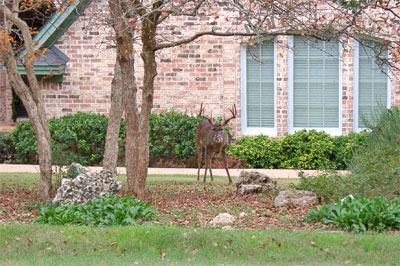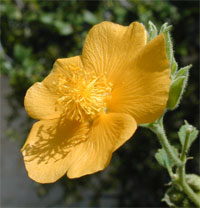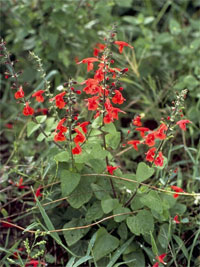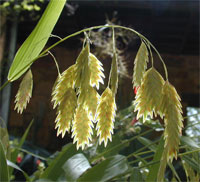Wild About Texas – April, 2009

Not your average garden guest. Photo by David Mahler.
Oh, Deer! A Gardener’s Challenge

Velvet mallow.
Photo by Joe Marcus.

Scarlet sage. Photo by Paul Cox.

Inland sea oats.
Photo by Joe Marcus.
Are you trying to fend deer away from your posies? If so, let me recommend the only plants that are truly deer-PROOF: silk and plastic! Realistically, from that standard and by necessity, we downgrade to “deer-resistant.” Fortunately, we do have a number of native plants that can hold their own against the deer. Refer to the list below for a few examples.
Generally, but not always, plants that are pungently aromatic or have white, silver, or fuzzy foliage, are left alone. Many succulents are also resistant; however, the flowers may be browsed if they are within reach. Thorns are not necessarily deterrents; for example, roses are notoriously harassed by these pests. Deer are browsers rather than grazers. This means they eat flowers, shrubs, and trees, but not grasses.
You may have found that new plantings get relentlessly nibbled or ripped from the ground and left to dry out. Creatures of curiosity, these ruminants will sample recent arrivals only to spit them out if they aren’t to their liking. Another theory is that plants fed salty fertilizers are particularly delicious and should be protected until the fertilizer is metabolized by the plant.
Since deer are habitual, they may consume a plant in one neighborhood while another population in another area won’t touch it. It is confounding when someone announces that deer don’t eat such-and-such in their yard, only to be contradicted by a friend who retorts, “Well, they sure eat it in my garden!” The best strategy is to observe what is spared on your block.
A few more strategies you could try include topical repellents such as urine from carnivores. (Yes, you can actually buy this stuff, and don’t ask how it is harvested!) It must be reapplied regularly but is effective, as is draping deer netting over your garden. Surrounding vulnerable plants with strongly resistant ones is another technique for moderate- to low-deer-pressure sites.
For gardens with a lot of space, my favorite suggestion — given by Patty Simons, the “Deer Lady” — is to encircle your area with fencing material rolled out on the ground 8 feet wide or more, elevated 6 to 12 inches using cinder blocks. This creates an unstable walking surface that deer won’t traverse. To camouflage the structure, grow vines such as Virginia creeper, snapdragon vine, or dewberry through the mesh.
Examples of relatively deer-resistant native Texas plants:
Velvet mallow*
Allowissadula holosericea
Milkweeds
Asclepias spp.
Inland sea oats
Chasmanthium latifolium
Damianita
Chrysactinia mexicana
Texas lantana
Lantana urticoides
Cenizo or Texas sage
Leucophyllum frutescens
Blackfoot daisy
Melampodium leucanthum
Gulf muhly
Muhlenbergia capillaris
Big muhly
Muhlenbergia lindheimeri
Switchgrass
Panicum virgatum
Mexican hat
Ratibida columnifera
Scarlet sage
Salvia coccinea
Autumn or Cherry sage
Salvia greggii
Ferns
various species
Frostweed
Verbesina virginica
* Hard to find, but great!
For more information about Texas native plants, visit the Wildflower Center’s website at: www.wildflower.org.
About the author: Andrea DeLong-Amaya is the director of horticulture at the Lady Bird Johnson Wildflower Center in Austin.
